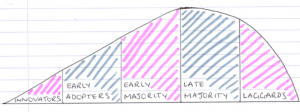What did we cover?
Today’s lesson was focused on describing the process and stages involved for digital adoption and evaluating platforms for different contexts.
What is digital adoption?
The world is integrating to digital whether we like it or not, digital adoption is about understanding how to adapt to this change and use it is how intended.
A very common misuse of digital adoption is that it is a business’s customer relationship management system (CRM), if all of your sales team are on board and using it to track and record every sales action then you could safely say that you are using it to its intent. Unfortunately, this isn’t always the case, a lot of companies are not using their CRM system to its full potential, with only some employees updating occasionally.
Diffusion of innovation model
This was a model that was introduced by marketers to help better understand exactly how a buyer adopts and engages with a new product or technology over time. It’s a model that is used by businesses when they want to gage how a new product or service is going to perform in a new market.
The diffusion model shows the five categories that a consumer can fall into and, as a business, how to engage with these different categories. This is the diffusion model:
These are the categories that make up the diffusion model:
- Innovator – Innovators are small groups of people that are exploring new exciting ideas and technology opportunities, the followers for these ‘gadget fetishes’ will typically have a lot of marketing content available to them, such as specialist blogs like Gizmodo.
- Early adopters – You would consider early adopters as the ‘opinion leaders’ because they share positive testimonials about a new product or service; early adopters seek improvements and efficiency. To get engagement from an early adopter it will require more persuasion than the innovator; However, they are receptive to change.
- Early majority – Followers that are likely to read reviews to understand to the product, they will look for product reviews via YouTube, YouTube is the platform the majority will find business product reviews.
- Late majority – They don’t tend to be keen on change, this category of consumer won’t tend to buy a new product unless there is strong evidence in the success of the product/ service or feel that they are being left out by not owning. To engage with this audience, businesses should provide marketing material, evidence and reviews from consumers in the ‘Early adoption’ stage.
- Laggards – Tend to prefer to ‘lag’ behind… these are not your trend setters! Laggards will only get on board with your product or service once they have researched statistics or felt pressure from others who have bought.
Evaluating platforms
Platforms have different strengths and weaknesses, it’s important to consider which platforms that are successful in different contexts. Platforms could be evaluated for the following contexts:
Depth and breadth of coverage
-
- How frequent is the content? 24/7?
- How many people are you reaching?
- Celebrity endorsements
- Websites give you a lot content, they are great for depth
Analytics and metrics
- How easily can you access metrics for a platform?
- Can you identify the success/ failure of a campaign?
- Using email platforms, you collect a variety of email stats (e.g. bounce rate, open rate), making the platform great for tracking your campaign
Collaboration and workflow
- What platforms enable you to collaborate with others?
- Crowdsourcing (e.g. social media)
Engagement
- Responsive marketing
- How easily can you measure customer engagement?
- Does the platform allow you to measure if it was a positive or negative engagement?
Scalability
- How efficiently can a campaign be scaled? Global?
- Does the platform allow you to tweak the budget spend? (e.g. AdWords)
- Can you run multiple campaigns at once?
These are the main points ….
Author
-
Emily joins the Napier Team as a digital marketing apprentice, with the support of Chichester College. Emily recently completed her A-levels in Fine Art, Photography and English Language.
View all posts

